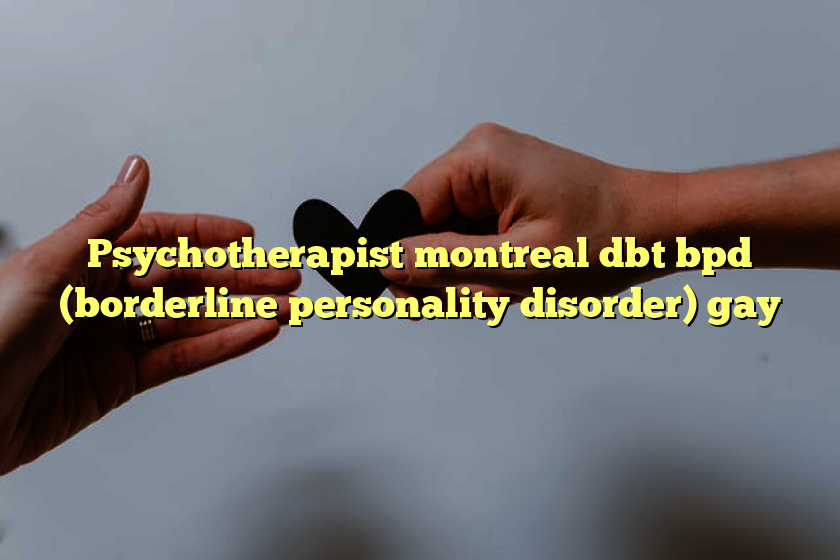-
What is the official address of Psychotherapist Montreal, DBT, Bpd (Borderline personality disorder), Gay?
-
What is the phone number for Psychotherapist Montreal, DBT, Bpd (Borderline personality disorder), Gay?
-
What are the business hours for Psychotherapist Montreal, DBT, Bpd (Borderline personality disorder), Gay?
-
How well is Psychotherapist Montreal, DBT, Bpd (Borderline personality disorder), Gay rated on Nicelocal?
-
Is the information placed on this listing reliable?
Psychotherapist Montreal, DBT, Bpd (Borderline personality disorder), Gay est parmi les lieux les mieux évalués à Montréalparmi la catégorie « Centres médicaux » de Nicelocal.Il a 2 évaluations des consommateurs,avec une moyenne de 5.La sociétéopèreà l’adresse suivante : Canada, Montréal, QC H3V 1G6, 5056 Ch. de la Côte-des-Neiges #203.La station de métro la plus proche est Côte-des-Neiges.
Les coordonnées GPS sont :longitude — 73°37′8.11′′W (-73.618917),latitude — 45°29′40.88′′N (45.494688).
Psychotherapist Montreal, DBT, Bpd (Borderline personality disorder), Gay opère selonles horaires suivants : Soleil-asseoir: 10:00 - 20:00.Vous pouvez en savoir plus en composant: le (514) 439—0919.
Si vous avez services de ce lieu par le passé,vous pouvez rédigerun avis dans la section « Avis » pour partagervotre avis sur Psychotherapist Montreal, DBT, Bpd (Borderline personality disorder), Gay.
I have experience working with mood related difficulties such as anxiety, depression, bipolar, obsessive and compulsive thoughts and behaviours, impulsivity, and self-esteem. In addition, I have also worked on treating identity issues including sexual orientation and gender; family related difficulties; cultural and religion related concerns; romantic and intimate relationship dynamics including infidelity and attachment; and finally difficulties related to experiences of trauma (sexual abuse and war).
I use strength based and humanistic approaches along with cognitive behavioural therapy, and/or emotionally focused therapy, and/or dialectical behavioural therapy. This is better explained in more details during an initial intake session that takes around 50min for individuals and 80min for couples.
Life contains moments in which we might slip, not know how to get back on track. In ‘Romeo and the Crow’, my mission is to guide you reconnect with your true self and values once again. In my view, therapy is effective only when it’s based on mutual trust and sensibility as a teamwork. The ‘crow’ symbolizes my knowledge to keep us focus on recovery.
What Is Fetishistic Disorder?
Fetishistic disorder is a subcategory of paraphilic disorders. A paraphilia is an intense and persistent sexual interest in atypical sexual targets or activities. A paraphilic disorder is a paraphilia which causes significant distress, functional impairment and/or harm to self or others. Most people who have fetishistic interests or who are affected by paraphilias do not experience significant distress or cause harm and would therefore not be classified as having a mental disorder.
Fetishisism disorder involves the repetitive use or dependence on a non-living object (shoes, leather) and/or a traditionally non-sexual body part (feet, hair) in order to achieve sexual satisfaction. Sexual fetishes frequently include both inanimate objects and body parts (legs in latex, feet in boots). The fetish object may create sexual arousal through any or all of the senses, including feel, smell, or appearance. Over time, individuals may also acquire extensive collections of fetish objects.
Fetishes involving inanimate objects fall into two general categories: form fetishes or media fetishes. Form fetishes center on the size, shape and appearance of an object whereas media fetishes focus on the texture or feel of an object. An object may fall into both categories, as is the case for a latex fetish; latex has both a specific appearance and a unique texture. An individual’s fetish may focus on the form or media aspects of an object more strongly in order to achieve sexual gratification.
During masturbation the fetish object may be held, tasted, smelled, or used to stimulate the genitals. Some individuals with fetishistic disorder may prefer solitary sexual activity even when in a reciprocal partner relationship. Other individuals may incorporate the fetish object in partnered sexual activity, often by asking a partner to wear or touch the object in order to achieve arousal.
Typically fetish objects are required or strongly preferred in order for arousal to occur. The more exclusively an individual’s arousal centers on a particular object or body part, the more likely it is that fetishism will cause distress in the form of anxiety or relational issues. A common impairment associated with fetishistic disorder is sexual dysfunction when the preferred object or body part is not present.
Women do not typically seek treatment for problematic fetishistic behaviors. More information is needed to determine whether fetishism disorder occurs at a clinically significant level within the female population.
Symptoms of Fetishistic Disorder
1
The main symptom of Fetishistic Disorder is a recurrent and intense sexual arousal from either the use of nonliving objects or a highly specific focus on nongenital body part(s), manifesting as fantasies, urges, or behaviors. A person with Fetishistic Disorder may feel shame and distress at the atypical focus of their sexual desire.
Symptoms of fetishistic disorder include:1
- Recurrent and intense sexual arousal from inanimate objects or nongenital body parts, persisting for at least 6 months
- These feelings cause clinically significant distress or impairment in social, occupational, or other important areas of functioning
- The fetish objects are not limited to the articles of clothing used in cross-dressing (which would instead be classified as Transvestic Disorder).
- The fetish objects are not limited to objects or devices specifically designed for the purpose of genital stimulation (eg. sex toys, such as vibrators or dildos).
Sexually active adults may occasionally become aroused by objects or by traditionally non-sexual body parts, but in the absence of fixation and mental distress, this attraction would not be classified as a mental disorder.
What Causes Fetishes?
Fetishes typically develop with the onset of puberty. Some theorists believe that the fetishistic interest arises due to an object or body part’s association with a person’s earliest experiences of sexual arousal or masturbation.There is no conclusive evidence regarding what causes or triggers fetishistic disorder.
Impacts of Fetishistic Disorder on Individuals & Relationships
Fetishistic Disorder commonly leads to shame and emotional distress in individuals who experience this type of arousal. Internal conflict and fear of judgment can lead to isolation and difficulty finding or honestly communicating in sexual relationships.
Partners of individuals with Fetishistic Disorder may feel inadequate, unattractive or worried about the implications of a fetishistic interest.
Sexual dysfunction often occurs when the fetishistic object is not present. Erectile Dysfunction (ED) or Delayed Ejaculation (DE) may lead individuals or couples to seek treatment.
Treatment of Fetishistic Disorder
Sex therapy with a certified therapist who specializes in paraphilias is the best form of treatment for fetishistic disorder. A certified sex therapist may utilize cognitive behavioral therapy (CBT) to identify and change the fetishistic behaviors. CBT has been proven to be effective for treating fetishistic disorder in combination with medication.
Sex Therapy
Sex therapy with a certified sex therapist who specializes in paraphilias will ensure a knowledgeable and non-judgmental approach to psychotherapy. A sex therapist will take a detailed sexual and psychosocial history to assess for factors that contribute to the fetishistic interest and its expression through urges, fantasies and behaviors.
The therapist will explore the onset and context of the symptoms being experienced, especially any changes in the situations or cues that have escalated fetishistic thoughts or urges. They will then likely offer coaching on mindfulness and behavioral techniques that either an individual or couple can explore. Co-occurring psychological conditions, such as mood disorders or hypersexuality, will also be assessed and treated.
Cognitive Behavioral Therapy (CBT)
Sex therapists with CBT training will employ cognitive restructuring techniques to identify and change thoughts and behaviors. They may utilize aversion therapy or guided imagery to reduce interest in fetishistic objects. Studies have shown CBT to be an effective treatment for Fetishism Disorder when utilized in conjunction with drug therapy.
Medication
Selective Serotonin Reuptake inhibitors (SSRIs) such as Prozac/fluoxetine can help with co-occurring mood disorders, such as depression or anxiety, lowering sex drive. Many people who take SSRIs will experience sexual side effects, often including diminished interest in sex. A lowered sex drive can help with the impulsivity associated with fetishistic thoughts and behaviors, however, does not directly address the fetishistic urge without therapy.
Medroxyprogesterone acetate and cyproterone acetate are members of a class of drugs that can be used to lower testosterone levels temporarily in order to reduce sex drive and allow for more effective therapy. These drugs help reduce the levels of circulating testosterone and prime the recipient for cognitive restructuring therapy techniques.
How to Get Help for Fetishistic Disorder
Most individuals who suffer from Fetishistic Disorder do not seek treatment due to embarrassment or fear of judgment. If you or your partner has a fetishistic interest that causes significant distress or impairment, seeking psychological help with a knowledgeable and nonjudgmental professional is an important first step.
When consulting a therapist for the psychological treatment of sexual issues, make sure that your mental health practitioner is AASECT (American Association of Sexuality Educators Counselors and Therapists) certified. “Sex therapist” and “sex therapy” are not protected terms, meaning that anyone can call themselves a sex therapist in their marketing. Additionally, most mental health licensure requirements contain little or no instruction in human sexuality. AASECT certified providers receive an additional 18-24 months of training and a minimum of 300 additional hours of supervision in sex-specific psychological issues.
Typical rates for an AASECT certified sex therapist are on the upper end of private pay therapy rates in your area. Most sex therapists see individual clients for 45-60 minute sessions at rates between $120-$180 and couples for 75-90 minute sessions at rates between $190-$310. These rates may vary widely based on the availability of certified sex therapists in your area and on general mental health costs in your state.
You can find an AASECT certified sex therapist by visiting our directory.
Fetishistic Disorder Statistics
Consider the following statistics about Fetisihistic Disorder:1
- Fetishistic disorder occurs almost exclusively in men
- Nearly one in four men with Fetishistic Disorder is homosexual
2
- Fetishistic disorder frequently co-occurs with other paraphilic disorders and/or hypersexuality
- Fetishistic Disorder frequently causes sexual dysfunction during partnered sexual activity when fetishistic objects are not present
- Fetishistic disorder typically develops with the onset of puberty/sexuality
- While the onset of Fetishistic disorder typically occurs early, symptoms may come and go throughout the lifespan of an individual
Living with Fetishistic Disorder
There are many coping methods and steps to take to manage Fetishistic Disorder.
If you are suffering from Fetishistic Disorder make sure to:
- Talk honestly with your partner(s) about your sexual urges and fantasies. Partners are more likely to be supportive and understanding when your behavior is not secretive or dishonest.
- Consult with a certified sex therapist to explore your options for reducing compulsive behaviors and co-occurring mental health conditions.
- Seek a community of other individuals struggling with Fetishistic Disorder or who have been successful in channeling their urges, fantasies and behaviors into a non-distressing sexual forum.
- Remember that, like most mental health conditions, FetishismDisorder is more effectively treated the sooner it is addressed.
Fetishistic Disorder vs. Other Disorders
Fetishistic Disorder is often misconstrued with fetishism or fetishistic behavior. It is also confused with other similar sexual disorders, including transvestic disorder and sexual masochism disorder.
Fetishistic Disorder vs. Fetishism
Fetishism is an outdated term utilized prior to the updated Diagnostic and Statistical Manual of Mental Disorders (DSM-5). The crucial difference in this new terminology is that Fetishistic disorder requires there be significant distress, impairment or harm accompanying the pattern of sexual behavior in order to be designated as a mental disorder.
Fetishistic Disorder vs. Transvestic Disorder
Transvestic Disorder is a paraphilia involving recurrent and intense sexual arousal from cross-dressing, as manifested by fantasies, urges, or behaviors. Fetishistic Disorder is not diagnosed when fetish objects are limited to articles of clothing exclusively worn during cross-dressing when a diagnosis of Transvestic Disorder would be more appropriate. As with any paraphilia, significant impairment or distress must be present in order to classify as a disorder.
Fetishistic Disorder vs. Sexual Masochism Disorder
When the fetish that an individual engages in primarily involves “forced cross-dressing” a diagnosis of Sexual Masochism Disorder should be considered first. Sexual Masochism disorder is a paraphilia in which the element of domination or humiliation associated with a fantasy or activity may be the core factor in fetishistic behavior. As with any paraphilia, significant impairment or distress must be present in order to classify as a disorder.
Fetishistic Disorder vs. Fetishistic Behavior
Individuals who self-identify as fetish practitioners or fetishists but do not report distress, impairment or harm to self or others are not classified as having a mental disorder.
Evolution of Fetishistic Disorder as a Mental Health Diagnosis
Fetishistic disorder has been included in the Diagnostic and Statistical Manual of Mental Disorders (DSM) under various iterations since its inception in 1952. Paraphilic diagnoses, especially fetishistic disorder, have been criticized as an attempt to control deviant behavior and arguably do not meet the criteria for true mental health diagnoses. Paraphilia diagnoses have been used to pathologize, stigmatize and discriminate against those who engage in alternative sexual practices. Fetishistic sexual interests, while atypical in their focus, do not constitute pathology or inherently cause harm.
Throughout subsequent editions of the Diagnostic and Statistical Manual of Mental Disorders (DSM) discernment was slowly made between consensual sexual practices which do not cause distress as compared to harmful urges, fantasies or behaviors which would constitute a psychological disorder requiring treatment. However, a lack of valid data or scientific consensus regarding the etiology of fetishistic disorder continues to make this diagnosis controversial.



